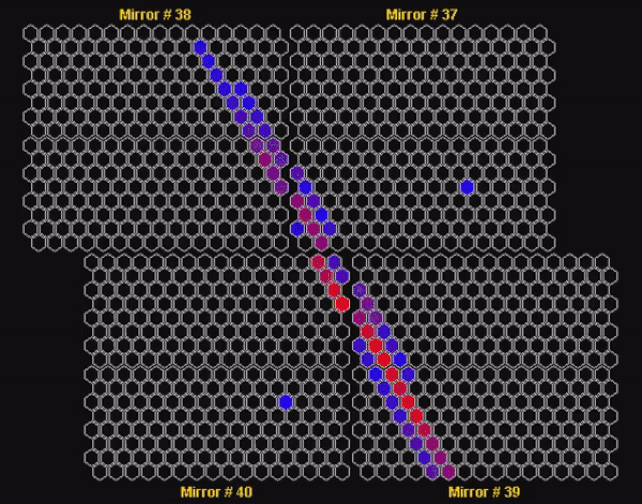A cosmic ray that smacked into Earth's atmosphere has absolutely gobsmacked astrophysicists.
The tiny particle was carrying in excess of 240 exa-electron volts of energy, or 2.4 x 1020 electron volts – second only to the famous, mind-blowing Oh-My-God particle detected back in 1991, with its 320 exa-electron volts.
But here's the sting in the tail. Just like the Oh-My-God particle, scientists were unable to track the new one to an obvious source.
"The particles are so high energy, they shouldn't be affected by galactic and extra-galactic magnetic fields. You should be able to point to where they come from in the sky," says physicist John Matthews of the University of Utah and member of the Telescope Array collaboration that made the discovery.
"But in the case of the Oh-My-God particle and this new particle, you trace its trajectory to its source and there's nothing high energy enough to have produced it. That's the mystery of this – what the heck is going on?"

Cosmic rays are a bit of a cosmic conundrum. We've been able to detect them for over a century, but we still don't really have a clear idea of all the different ways they can be propagated throughout the Universe.
They're not actually radiation, like light; they're particles, mostly atomic nuclei, but also sub-nuclear particles such as protons and electrons. And they stream through the Universe at close to the speed of light, with more power than they should have.
Scientists think that they're produced in energetic circumstances, such as supernovas and stellar collisions. Less energetic sources such as stars (including the Sun) produce lower-energy cosmic rays, but the more powerful ones are proving a little bit harder to pin down.
Our atmosphere protects us from cosmic rays, which is actually great, but we still have some pretty effective ways to detect them.
When a cosmic ray hits the atmosphere, it collides with other particles therein, producing a shower of particles that falls to Earth. We have observatories that can detect these particles, linking them to the cosmic ray collision that produced them.
However, the showers produced by energetic cosmic rays rain down over a relatively large area, which means we need to cover a pretty big patch of ground if we want to reconstruct the particle event with any accuracy.
The Telescope Array, run by an international collaboration, has an effective detection area of 700 square kilometers (270 square miles).

On 27 May 2021, the array picked up a signal. After performing calculations and analysis, and checking and re-checking, the Telescope Array collaboration concluded that they had found a particle on the energy scale of the Oh-My-God particle.
"When I first discovered this ultra-high-energy cosmic ray," says physicist Toshihiro Fujii of Osaka Metropolitan University, who led the research, "I thought there must have been a mistake, as it showed an energy level unprecedented in the last three decades."
The discovery, made using a different technique from the one that revealed the Oh-My-God particle, and in a different part of the sky, suggests that, while rare, these observations represent real astrophysical events. The Oh-My-God detection was not a fluke, nor a mistake.
The research team has named the new particle Amaterasu, after the powerful Shinto goddess of the Sun. Both, researchers say, are probably protons.
And, well, the confirmation of ultra-high-energy cosmic rays means we now have a bit of a pickle on our hands. You see, ultra-high-energy particles have a distinct cut-off, an energy known as the Greisen-Zatsepin-Kuzmin limit, which sits at 5 x 1019 electron volts.
This is thought to be the maximum energy a particle can maintain over long distances of around 160 million light-years, since cosmic rays lose energy as they travel through space.

There's stuff within that distance from us that could produce cosmic rays, obviously, but nothing even close to powerful enough to produce Oh-My-God or Amaterasu has been detected within 160 million light-years of the Solar System.
"Things that people think of as energetic, like supernovae, are nowhere near energetic enough for this," Matthews says. "You need huge amounts of energy, really high magnetic fields to confine the particle while it gets accelerated."
And tracing the line Amaterasu seems to have traveled through space leads back to a cosmic void – a region of space between the filaments on which galaxies tend to cluster, with relatively little within. This means that there's something we're missing somehow.
Perhaps magnetic fields are better at particle acceleration than we thought. Perhaps there's a nearby source we haven't seen. Or perhaps the particles are pointing us to a never-before-seen astrophysical phenomenon.
"It could be defects in the structure of spacetime, colliding cosmic strings," says physicist John Belz of the University of Utah.
"I mean, I'm just spit-balling crazy ideas that people are coming up with because there's not a conventional explanation. It's a real mystery."
The research has been published in Science.
